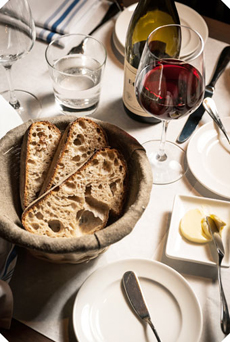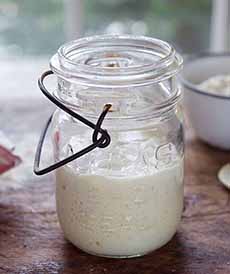FOOD HOLIDAY: National Sourdough Bread Day
|
April 1st is National Sourdough Bread Day. Sourdough is an ancient bread made by a long fermentation of dough, using naturally occurring lactobacilli bacteria and wild yeasts (other types of breads use cultivated yeasts, which became available only in the 19th century). In comparison with breads made with cultivated yeast, sourdough usually has a mildly sour taste and aroma, the result of the lactic acid produced by the lactobacilli. The preparation of sourdough begins with pre-fermenting, using a “starter” made from flour and water (the starter is also known as levain, the chief, chef or head). It can be a fluid batter or a stiff dough, as the ratio of water to flour varies by baker. The starter helps to develop the uniquely tart flavor of sourdough bread. Starters are maintained for years, even generations. The colony of bacteria and yeast inside the dough is kept alive by the baker, who needs only a piece of it to bake a new batch of bread. If you bake bread in a bread machine, note that the rise time of most sourdough starters is longer than that of breads made with baker’s yeasts. Thus, sourdough typically doesn’t work in a bread machine; you need to use conventional baking techniques. One of the oldest sourdough breads was found in a Swiss excavation; the site dates to 3700 B.C.E. But the origin of sourdough fermentation is likely thousands of years older than that, originating in the Fertile Crescent of Mesopotamia. Bread production has relied on the use of sourdough as a leavening agent for most of human history (the alternative to leavened bread was flatbread, such as lavasch and tortillas). The development and use of [cultivated] baker’s yeast as a leavening agent dates back only 150 years. Sourdough starter from a prior batch is used to create the new batch. Sourdough remained the usual form of leavening in European into the Middle Ages. Then, it was replaced by barm, the yeast-laden foam that forms in the process of brewing alcohol (for bread, the barm typically came from beer brewing). Centuries later, scientists learned to culture yeast, so bakers no longer had to rely on barm. French bakers brought sourdough techniques to Northern California during the Gold Rush (1848–1855), and the bread remains part of the culture of San Francisco, where it has been in continuous production there since 1849. Some bakeries can trace their starters back to those days! In English-speaking countries, where wheat-based breads predominate, sourdough is no longer the standard method for bread leavening. It was gradually replaced, first by the use of barm from beer making and then by cultured yeasts. Thanks to the artisan food movement in the late 20th century in the U.S., it has undergone a revival [Source]. Now, most of us can enjoy it whenever we like—for toast, sandwiches and in the bread basket. If you haven’t had sourdough bread recently, today’s the day! > CHECK OUT THE DIFFERENT TYPES OF BREADS IN OUR BREAD GLOSSARY |
|
|
|
|
||


